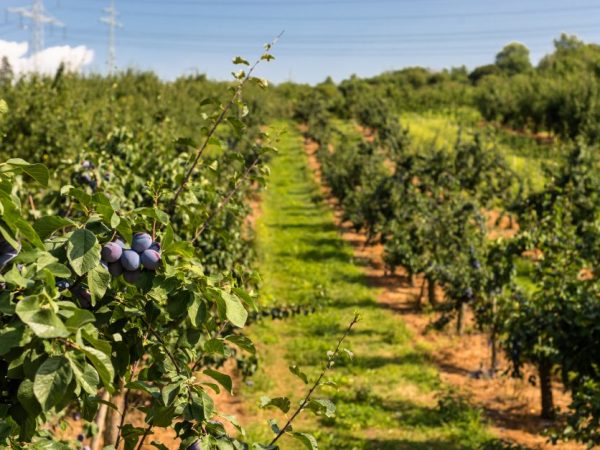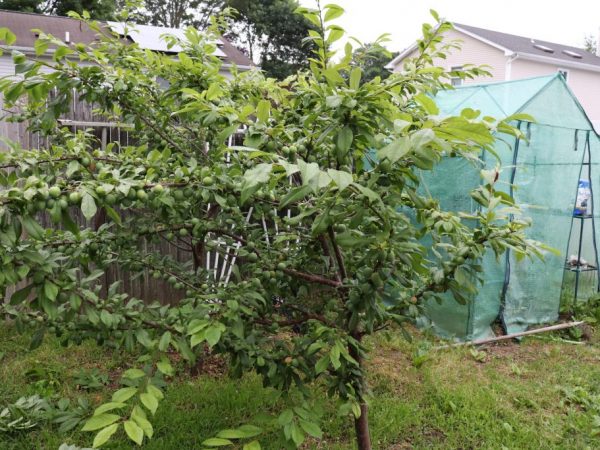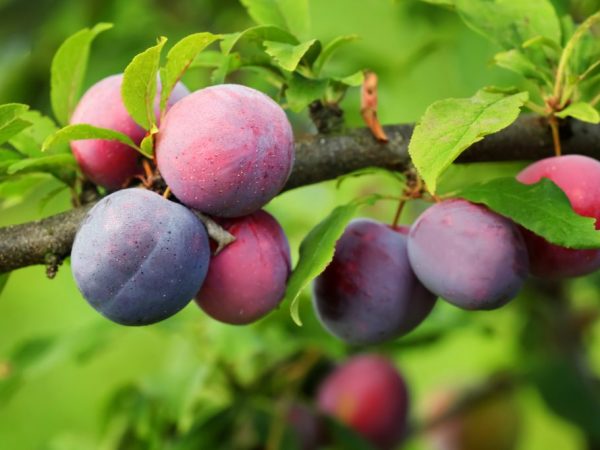How to care for plums in autumn - main activities
Proper care of plums in autumn is the key to a good future harvest for the next season. It includes a number of mandatory activities within the time frame established for different regions.

How to care for plums in autumn - main activities
Feature of autumn care
It is necessary to take care of the plum throughout the growing season.
If spring care is aimed at increasing yields, and summer care is aimed at prolonging the fruiting stage, then autumn is associated mainly with preparing for winter, so that the fruit plant can successfully endure frosts and quickly recover in spring.
During this period, they try to dig up the ground and apply fertilizers in order to ensure a good harvest for the next season.
- They dig up the soil at a distance of about 1 m from the place where the plum grows. Depth - up to 0.3 m. It is possible to dig up the ground around trees only a season after planting.
- Humus, wood ash and superphosphate are introduced. Urea is allowed in small quantities.
Watering rules
The need for watering directly depends on the weather conditions. With a warm and dry autumn, abundant soil moisture will be required. With frequent rains, they stop watering the trees.
If an excessive amount of precipitation falls, trenches are made around the trunks of the plums, through which excess water will go into the soil layers.
Watering requirements:
- when groundwater passes at a sufficient depth, the soil is moistened at a level of up to 2 m from the surface;
- in moist clay soils, moisture is sufficient up to 1 m below the top layer of the earth.
They try to water the plum garden at the end of autumn, when leaf fall ends. Consumption rate per plant - 35 liters.
To retain moisture, lay out a layer of mulch.
Cutting technology
Intensive growth of the plum crown leads to nutritional deficiencies and adversely affects yield indicators. This fruit crop requires pruning, which is one of the mandatory autumn activities.
Removing overgrowth and timely crown formation helps to increase the stability of the plum in winter and promotes proper growth.
Prune the plant at the time recommended for the regions:
- gardeners of the middle lane and the Moscow region begin to trim the crown after the final harvest and the completion of the leaf fall;
- in cold climatic areas, for example, in the Urals, Siberia and the like, they try to shorten the stone fruit culture in the spring, closer to summer, because the planned autumn pruning often does not work due to the sudden onset of cold weather.

Pruning helps the plant grow
The formation of a fruit tree is carried out using a special technology:
- for annual seedlings, which were planted in the current season, the stem is cut by 2/3, and the shoots are shortened by 1/3;
- biennial and three-year-old plants are thinned out, cutting the length of the branches by 30-40 cm, starting from the tops, long branches that stand out from the total leaf mass are cut by 1/3, the length of the lateral ones is reduced by 15 cm;
- actively fruiting plums are subjected to a sanitary procedure, in which all sick, damaged by pests, broken branches with mechanical damage, the central conductor are completely removed, in case of excessive stretching, they are cut to the level of the common crown, and rapidly developing shoots are removed.
The basic rule for autumn pruning is to trim the shoots in stages, for 2 or more approaches. The last event is planned 2-3 weeks before the cold snap.
Creating protection for the winter
Plum requires shelter for the winter. To do this, mulching is carried out or the root system is covered with a covering material. Burlap is used as it in several layers. Cover with polyethylene from above and sprinkle with earth.
Whitewashing the trunk helps to protect the trunk from frost cracks, cracking and burns when sunlight reflects from the snow crust. This also reduces the risk of insects remaining under the bark of the larvae.
Pre-existing damage on the bark is cleaned to a healthy layer of wood, covered with a disinfectant and covered with garden varnish.
Whitewashing is carried out in dry weather at the end of the leaf fall at an air temperature of up to 3 ° C. Apply with a brush in a thick layer to the entire trunk and bases of skeletal branches.
Regional features
Middle lane
Residents of the middle zone and the Moscow region perform all the procedures that are provided for autumn care, without restrictions.
Plums are thoroughly watered, fed abundantly, cut to the maximum possible length of the crown and dug up the soil to ensure adequate oxygen access.
In warm regions, trees are not sheltered, but mulch is used.
Volga region
On the territory, protection is often used in the form of a hut structure, which closes the plants from wind flows. They make it from spruce branches tied with twine. Mint is folded inside, which will scare away rodents from the trees.
Ural
Gardeners of the Urals provide winter protection for all plums. Autumn care includes pre-winter watering and pruning. Plants are partially cut off so as not to completely weaken them before the onset of frost.
Siberia
In the harsh climate of Siberia, all trees are subject to insulation, regardless of their age. At the same time, they try not to feed or water them before the onset of cold weather in order to prevent the roots from freezing.
The fruit crop is carefully insulated: the stem, the skeletal branches are wrapped with roofing material or other suitable material, on top - with a layer of reflective foil.
Pest control methods
In preparation for winter, the plum is carefully inspected for the presence of pests and signs of infection. pathogens and parasitic insects remain for the winter, and when warm comes in the spring they become more active, which can adversely affect future flowering and harvest.

Pests spoil the harvest
For therapeutic and prophylactic purposes:
- completely remove leaf litter in the area of the trunk circle;
- protect the places of bark discharge from wood layers;
- moss and lichen outgrowths are removed from the branches and trunk;
- cut dry and diseased branches;
- treated with insecticidal and fungicidal preparations;
- whitewash the boles.
Pest control technology:
- the near-trunk circle is closed with unnecessary material on the perimeter of the growth of the plum crown;
- mechanically shake the insects on it from the tree;
- dead fragments of the bark are cleaned with a scraper, in the same way they remove the growths of moss and lichens, thereby removing the oviposition;
- a brush with a metal bristle is used to treat the surface of the cleaned areas without touching healthy wood;
- skeletal and side branches, as well as the trunk at a distance of 0.7 m, are sprayed with insecticidal solutions and fungicides of the systemic spectrum of action;
- the remains of the bark, collected moss and lichens are burned outside the garden to avoid the preservation of larvae in them.
More often, gardeners use urea with a concentration of 5% (500 g / 10 l of water) for treatments. The work is carried out in the morning or evening hours, in the absence of precipitation and wind.
An additional prophylactic agent against pests are infusions:
- 2 garlic heads;
- 2 cups onion skins
- 50 g of crushed laundry soap;
- 5 liters of water.
To prepare a working solution, garlic is mixed with onion peels, soap is added, water is brought to a boil and the prepared mixture is poured into it. The infusion is kept until it cools completely, filtered through a layer of gauze and sprayed on the garden.
In case of mass damage to a fruit crop, specially developed means are used, for example, Karbofos, Aktara, Nitrofen.
Soil loosening
After watering and heavy rains, the soil near the plum tree should be loosened to increase its breathability and provide the roots with oxygen before winter.
The procedure is carried out a meter from the trunk so as not to damage the root system.
Common mistakes
Gardeners making mistakes when leaving in the fall can lead to a decrease in yield for the next season. Typical violations include:
- ignoring autumn treatments for pests and infectious diseases;
- leaving leaf litter in the area of the trunk circle;
- lack of stripping boles from moss, lichens and dead bark;
- incorrect cropping.
All these mistakes lead to a weakening of the tree before winter and affect the overall frost resistance.
Summing up
If you take proper care of the plum crop in the fall, it will favorably withstand the coming winter cold and will quickly recover in the spring.
Preparatory work in the garden includes pre-winter watering, pruning and covering the plants.
All activities are done within the time frame established for a particular growing region. Novice gardeners should adhere to the basic recommendations in order to avoid common mistakes and not damage the health of the plum.

